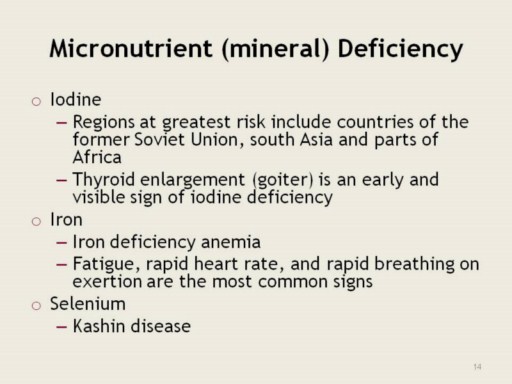| front |1 |2 |3 |4 |5 |6 |7 |8 |9 |10 |11 |12 |13 |14 |15 |16 |17 |18 |19 |20 |21 |22 |23 |24 |25 |26 |27 |28 |29 |30 |31 |32 |33 |34 |review |
 |
Iron and Iodine deficiency are the most common mineral deficiencies world-wide.
According to WHO, “iodine deficiency is the world’s most prevalent, yet easily preventable, cause of brain damage.” http://www.who.int/nutrition/topics/idd/en/ Iodized salt is the cheapest and easiest way to prevent iodine deficiency, and now almost 70% of the world’s households use iodized salt. http://www.iccidd.org/
Those most at risk for iron deficiency anemia include pregnant women, infants, children during puberty due to rapid growth, and the elderly. Insufficient dietary intake and poor absorption are the primary causes of iron deficiency anemia.
Selenium deficiency is rare, but Kashin disease is a cardiomyopathy that mostly affects women and children in selenium-deficient regions of China Siberia, and North Korea, where the soil is very depleted in selenium. Reeves MA, Hoffmann PR. The human selenoproteome: recent insights into functions and regulation. Cell Mol Life Sci. 2009 Aug;66(15):2457-78. Epub 2009 Apr 28. http://www.ncbi.nlm.nih.gov/pmc/articles/PMC2866081/?tool=pubmed |